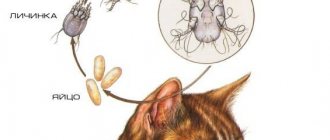Ear mites in kittens and adult cats are not so rare. In the absence of timely, qualified treatment, a pet can not only lose hearing, but also die. That's why it's important to keep an eye on your animal: if your cat is shaking its head and scratching its ears, it's time to check it for ticks.
What does an ear mite look like in cats?
Mites in the ears of cats are a disease called otodectosis. The disease can manifest itself not only in street cats, but also in domestic fluffies. It should be noted that kittens are most susceptible to the disease.
The parasite actively feeds on particles of the dermis. As a result, severe itching begins, which gives the cat no rest. She begins to behave differently, she may lose appetite and sleep, or, conversely, be constantly lethargic.
At the initial stage, ear mites in a cat look like ordinary dirt. Many breeders are unaware of the disease. If you carefully examine the auricle, you will notice dark, thick deposits with an unpleasant odor. What does ear mites look like in cats if the disease starts? This is a severe inflammation inside the ear, covered with a dark brown crust. At this stage, serious treatment is required.
Initially, the animal will not show any reactions. However, as the parasites spread, the infected person becomes increasingly restless. You may notice the cat shaking its head or constantly scratching - severe itching affects the entire top of the head.
If you look at the parasites under a microscope, you can see that the mites in the ears of cats are about 0.2 - 0.7 mm in size. Their body shape is elongated, oval. The proboscis is located on the head part. Short limbs and a pale yellow tint of the body indicate a pest that lives on the inner area of the ear, and sometimes on the eardrum. The infection development cycle itself is completed in fourteen days. The parasite is able to easily pass from one animal to another, including dogs and other pets.
Photo of otodectosis in cats
Ringworm in cats - main signs, symptoms, prevention and treatment of ringworm in cats (105 photos)Pancreatitis in cats: first symptoms, nutritional nuances and treatment options (125 photos and videos)
Subcutaneous mites in cats - first symptoms, treatment options and real photos of examples of parasite damage (110 photos + video)
Read here Peritonitis in cats - first symptoms, diagnosis, treatment and prevention (80 photos + video)
Help the site, share with friends 
2
Why is otodectosis dangerous?
In most cases, two ears are affected at once. The possibility of infection increases during warm and humid periods of the year. Small kittens and weak pets are at risk. Interestingly, it can take a year from the moment of infection to the appearance of the first signs. The disease will become noticeable when a bacterial infection is attached to it. The furry friend will constantly experience discomfort, will not eat, sleep, and will start shaking his head.
The ear will scratch due to unbearable itching. This damages the capillaries and leads to the appearance of large hematomas. In the area where the skin has been damaged, infection in the form of bacteria or fungi penetrates. The inflammatory process starts, tissue swelling, redness, and pus appear.
If the inflammation is not stopped, it will spread to the eardrum, and this can lead to weakening or loss of hearing. At this time, your furry friend will behave irritably, nervously, even aggressively. Over time, inflammation can reach the head. The prognosis in these cases will be disappointing - the pet may die from the tumor.
It is important to avoid complications. If you notice deviations similar to the symptoms of otodectosis, contact a professional doctor immediately.
How do you get infected with otodectosis?
Ear mites in cats can appear if the animal has been walking outside and has been in contact with other cats. Most homeless animals suffer from otodectosis. If you let your pet outside, you should carefully examine it after a walk and do not neglect the rules of hygiene.
There is a possibility of introducing ticks on shoes or clothes. The owner can pet an infected feline or simply walk past a pack of stray animals - and this will be enough for the parasite to travel to a completely domestic cat.
There is a high risk of the disease appearing in those homes where similar cases have already occurred. Ear mites in a kitten are transmitted from the mother, as well as through carpets, various products, home furniture - everything that can accumulate dust particles and microorganisms.
Routes of transmission of ticks from one individual to another
The most common variant of infection is contact with already sick animals. It is enough for one cat to sniff another for several parasites to leave the host and be transmitted to a healthy animal. But there are also indirect methods of infection.
Cat ear mites live up to two months in their natural environment, which means they can be picked up through indirect contact. The disease is transmitted through care products: scratchers, carriers, bedding. Sometimes the infection is carried by fleas or flies.
If a room is not regularly cleaned, the mite settles there, waiting for a host. This should be taken into account when moving or when leaving a cat as a guest for a while.
At elevated temperatures the parasite lives even longer. It stays on clothing and shoes. Therefore, it is important to protect your cats from contact with outdoor shoes and outerwear - ideally, there should be a closed closet in the apartment.
To summarize, we can say that the main “helper” of otodectosis infection is unsanitary conditions. A domestic cat that is carefully cared for, vaccinated and kept clean has the least chance of getting sick.
Progression of the disease in stages
Otodectosis is the most popular skin disease. Ear mites in cats are diagnosed in 85% of cases when breeders treat suspected otitis media. The carpet beetle corrodes the upper surfaces of the epidermis, located on the inside of the shell. The disease proceeds as follows:
- Mechanical injury. At this point, the upper layers of the dermis are damaged. With its powerful mouthparts, the parasite chews the surface, obtaining blood and lymph. The nerve endings become irritated, resulting in severe itching.
- Blood vessels begin to thin out. They become filled with blood, redness and swelling appear.
- You may notice persistent discharge in areas of damaged skin.
- Dark brown scabs form from dead skin cells, as well as other waste products of pests. The whole process is accompanied by the formation of putrefactive microflora.
- There is a gradual accumulation of scabs and crusts, which leads to the formation of a plug. Hearing begins to become dull. If measures are not taken, the eardrum will rupture. The infection opens up to the middle and inner ear.
If parasitosis is advanced, then an active inflammatory process develops in the inner and middle ear. The symptom is a certain behavior of the animal: the sick person walks with his head turned 90 or even 120 degrees. The ear that hurts will point downwards. This process leads to the spread of pathology to the membranes of the brain, sepsis and, as a result, death.
Breeders need to remember that such a simple disease can result in disastrous consequences. But even in advanced cases, it is possible to successfully treat ear mites in a cat and avoid serious consequences.
Possible complications of otodectosis
Complications of otodectosis include:
- bacterial or fungal otitis - are the most common complications of otodectosis;
- hematomas and lymphatic extravasations of the auricle are also common, are the result of self-harm and require the participation of a veterinarian. Hematomas are formed when a blood vessel is damaged, lymphatic extravasates - when a lymphatic vessel is damaged by a cat’s claws. In this case, an accumulation of blood or lymph occurs in the tissues of the ear, which requires opening and draining the resulting cavity with evacuation of its contents. Otherwise, suppuration will occur, which will result in permanent scar deformation of the ear. The opening and drainage of the hematoma or lymphatic extravasation is performed by a veterinarian;
- miliary dermatitis (eczema) - develops in some cats because mite saliva and feces are strong allergens. At the same time, numerous bubbles appear in the ear area, which, when opened, turn into erosions covered with dry crusts. This increases inflammation, pain and skin itching, significantly worsening the cat’s condition;
- perforation of the eardrum and the development of otitis media and internal otitis: leads to decreased hearing up to its complete loss, but with a small hole size and proper treatment, the membrane is quickly restored;
- leads to the appearance of peripheral vestibulopathy, while: the coordination of movements in the cat is impaired;
- Characteristic is a lateral tilt of the head, the affected ear facing downwards;
- the cat can move in a circle;
- Nausea may occur when moving;
- strabismus occurs.
- extremely serious condition of the cat;
Ear hematoma often occurs during otodectosis as a result of self-injury; opening and emptying of hematomas is carried out by a doctor in a veterinary clinic
Symptoms and diagnosis
The owner’s attention is the key to ensuring that any disease is suppressed in the bud in a timely manner. Ear mites are not the most difficult disease to recognize. So it won't be difficult to notice him.
When there is suspicion of otodectosis
You should suspect otodectosis if your furry friend begins to itch frequently. Infection can be determined externally:
- restlessness and shaking of the head, as if a furry friend is trying to throw off some kind of burden;
- dirty brown liquid in the ear canal – it will have a pungent odor;
- the auricle turns red - this is how irritation manifests itself;
- hair may fall out on the outside of the ear and purulent ulcers may appear;
- body temperature periodically rises, accordingly, the animal becomes lethargic - this is the stage of inflammation;
- hearing is partially or completely lost;
- impressive accumulations of sulfur and brown discharge are noticeable;
If the temperature is normal, the pet may meow, run from room to room, and show severe anxiety. In complicated forms, the head begins to tilt towards the affected ear, and the cat itself falls into an apathetic state, loses appetite and moves little. Immediately contact a professional who will help you deal with the situation quickly.
Diagnosis by a veterinarian
Only a qualified veterinarian will determine how to treat ear mites in cats. Before visiting a doctor, the owner can only determine the presence of pests. To do this you will need a cotton swab and a piece of dark fabric:
- use a stick to remove as much of the mass as possible from the ear;
- tap with a stick over a dark surface to shake off pests;
- A bright light is directed onto the area being examined;
- Under a magnifying glass they examine the consistency of the mass: the moving yellowish dots are mites.
Next, you need to urgently go to the doctor. The effectiveness of treatment always depends on how soon the owner seeks professional help. Even if you know traditional methods, you should still ask your doctor how to cure ear mites in cats.
In addition, the veterinary hospital will conduct an examination, a microscopic examination, take a scraping and check the hearing organs. This will not only confirm the diagnosis, but also establish the stage of the disease. According to the neglect, treatment will be prescribed.
Diagnosis of otodectosis
The determination of any disease must be carried out by specialists in the clinic. Thanks to modern research methods, it is very easy to understand the cause and stage of a particular problem.
When the first signs of otodectosis appear, you should immediately contact a veterinarian. Using laboratory analysis, discharge and crusts from the affected area are examined under a microscope.
This is why it is important for a sick animal to be examined by a doctor. The veterinarian will prescribe all the necessary medications against otodectosis for the cat, which will help cope with the disease.
It is also possible to determine the disease at home. To do this, soak a cotton pad in vegetable oil and use it to collect crusts from the sore ear.
Next, apply eyeliner or black mascara to a cotton pad. White mites will be more visible against a dark background.
When ticks are found, it is easy to identify otodectosis. But in the early stages, this option will not help for determination. That is why it is better to entrust the diagnosis of otodectosis in a cat to a doctor.
Seizures in cats - main causes, symptoms, first aid, treatment and choice of drugs (110 photos)Polycystic kidney disease in cats - causes, diagnosis and symptoms of the disease. Treatment options and prevention of kidney disease (95 photos)
Tartar in cats - signs of the disease and methods of fully treating tartar (125 photos + video)
Therapy and care
Many people are interested in how to treat ear mites in cats if there are other animals in the house? First, you need to isolate the sick person from other animals, throw out all bedding, rugs and other textiles on which the cat was located from the house. The apartment is thoroughly washed with disinfectants. The treatment of a sick animal is carried out wearing gloves and clothing that is not taken out of a closed room or closet.
The main rules for treating ear mites in cats include the following:
- If there are several furry inhabitants (cats or dogs) in the house, then everyone will have to be treated - regardless of whether they have the disease or not. For kittens and pregnant animals, it is worth using a gentle spray.
- Don’t forget about careful cleaning of your home. It is better to throw away bedding and rugs, or, as a last resort, boil them.
- It is worth remembering that a pet’s recovery directly depends on the strength of its immunity. Provide the patient with balanced, high-quality food and include vitamins in the diet.
- Clean your home more often. Remember that harmful microorganisms settle on various objects, in cracks in the floor, in fabrics and even in books.
- Never use products containing ethyl alcohol to treat ear mites in cats.
The duration of treatment for ear mites in cats will depend on the degree of neglect of the disease and on the drugs chosen. Simple cases can be resolved in one to three weeks. But in case of complications, when there is a secondary infection, the treatment process will drag on for several months.
Hygiene procedures and processing
All medications will be prescribed by a doctor. He will also tell you about the treatment regimen. Further actions will be approximately as follows:
- First of all, the surface of the ears is cleaned of crusts and dried particles, and the hair that gets in the way is trimmed.
- Warm hydrogen peroxide is carefully and slowly injected using a syringe. 2-3 ml is enough. You have to wait 15 minutes. You can replace this substance with olive oil.
- Using tweezers and a cotton swab, carefully clean out all the secretions. Dirty swabs are placed in a closed container. After completing the manipulations, they must be burned.
- After the ear canal has been thoroughly treated, 1-2 ml of acaricidal liniment or solution prescribed by a veterinarian must be administered, heated to 32 degrees (slightly warmer than room temperature).
- The auricle is bent and a small massage is given for about five minutes.
- Acaricidal powders are blown into each auditory organ or special aerosols and drops are used.
Such manipulations are repeated three times every week, but the exact schedule of procedures will be drawn up by a veterinarian. External cleaning of the ears is carried out daily.
Drug treatment
There are various medications for ear mites in cats, produced in Russia and abroad. The most popular are ointments for ear mites in cats or drops. There are also sprays that can be used to treat bedding, the cat’s body and its “personal items”. The ointment has the longest working time, but it is not as easy to apply as drops or spray. What remedies for ear mites in cats in the form of drops does modern pharmacology offer:
1. Amitrazine
. It is quite popular because it has a triple therapeutic effect: it destroys infections, fungal infections and subcutaneous pests. The substances begin to act immediately after instillation. This option is considered less toxic. The positive thing is that there are no negative effects.
2. Otoferonol
. This option is similar to the previous one. This is an excellent substance for ear mites in cats. Drops have low toxicity. They are comfortable and safe to use for treating kittens. It is only important to dose and apply the substance correctly. This drug must be injected into two hearing organs at once, even if only one is damaged.
3. Tsipam
. The medication has no side effects or contraindications. If the intervention is started in a timely manner, the treatment can be carried out only once. If the disease is advanced, you will have to repeat the manipulations every week until the condition finally improves.
4. Drops Bars
. They are instilled directly into the auditory organ, 3 ml each. If purulent inflammation is present, the dosage is increased. The areas need to be treated for seven to ten days intermittently. However, side effects often occur due to individual sensitivity.
Use ointment as an aid. The doctor will prescribe Aversectin ointment, Amidel-gel. Vedinol Plus, Ordermil.
Acaricidal powders are also used in veterinary medicine
:
- Phenothiazine
. It has a light yellow tint and a weak specific odor. The substance has a strong acaricidal, antimicrobial and anthelmintic effect. The drug is low-toxic and can be stored in closed packaging for quite a long time without losing its properties.
- Fine sulfur.
Light yellow powder that is insoluble in water. It should be used as part of a set of measures when infected with mites or fungi. The product can be purchased at any veterinary pharmacy, the drug is widely available.
A small dose of powder is poured into the hearing organ using paper. The advantage of the powder is its uniform distribution, the disadvantage is that it is quite difficult to apply. If your cat does not tolerate treatment procedures well, it is best to stop with drops.
Radical methods of therapy include the special antiparasitic drug Ivermectin, which is administered subcutaneously. The instructions contain the exact dosage, calculated based on the weight of the animal. This substance is very toxic, so it is prohibited for use outside veterinary clinics. It should not be used for small kittens, pregnant or weakened animals.
If otodectosis is advanced and signs of meningitis appear, then antibiotics, immunomodulatory elements, and vitamins are used for treatment. Such a “severe” patient is usually admitted to a hospital.
Folk remedies: useful and dangerous
At the first signs of otodectosis, you can try using folk remedies. In this case, it is necessary to carefully monitor the entire process so as not to prolong the disease. Before starting home therapy, be sure to consult with a veterinarian - you can call the veterinary clinic and agree on treatment measures over the phone.
Popular options include almond butter and strong green tea. They are used to treat mite-affected areas. It is important to observe personal hygiene measures here: carry out all manipulations only with special gloves. It is worth doing the procedures regularly, otherwise they will not give results.
All products must be fresh and at a comfortable temperature. To do this, they are slightly heated.
It must be remembered that some folk remedies for ear mites in cats can cause harm rather than benefit. For example, some owners prefer to use soda or crushed garlic, but they can lead to poisoning. Even worse is to use celandine, since it is extremely toxic not only to pests, but also to animals.
To avoid harming your pet, consult your doctor about each decoction or drug. Ideally, folk remedies should be combined with medications - only then the treatment will bring quick and positive results.
Danger to humans and other animals
Many owners fear that ear mites are dangerous to humans. However, otodectosis is not transmitted to people or even small children. But for other pets the disease is dangerous, as it is easily and quickly transmitted.
It is worth remembering that a person can become a carrier of parasites without getting sick. Therefore, it is easier to keep the house clean and care for your pet than to treat it later.
Prevention
Proper care of your pet will prevent infection with ear scabies. It is important to avoid contact with sick animals, pay attention to the cleanliness of cat care items, periodically wash and, if possible, disinfect bowls, trays, bedding, and carriers. It is necessary to minimize the likelihood of your cat interacting with stray animals, as they may be infected with ear scabies.
Regular cleaning of the premises using an insectoacaricidal agent will prevent re-infection of a recovered cat. This will get rid of ticks. which could get on the floor and furniture.
If you find an error, please highlight a piece of text and press Ctrl Enter.
Prevention of the disease is carried out through annual examinations at the veterinary hospital, regular treatment of the ears with special solutions and strengthening the animal’s immunity.
Author of the article: Alena Nikolaevna Ushakova, veterinary therapist
Measures to prevent otodectosis:
- preventive treatment with acaricidal drugs, which are often included in drugs that prevent the appearance of fleas;
- preventing cat contact with stray animals;
- regular monitoring of the condition of the cat’s ears;
- when introducing a new pet, especially one taken from the street, into an established cat community, you need to make sure that it does not have otodectosis;
- regular wet cleaning of the premises where cats are kept;
- steam treatment of beds and soft toys, regular washing of bedding;
- avoiding overcrowding when keeping cats.
If one of the cats living in the house becomes ill with otodectosis, then all pets must be treated, since otodectosis is a highly contagious disease.











